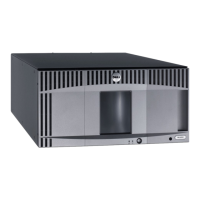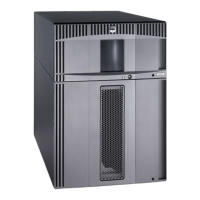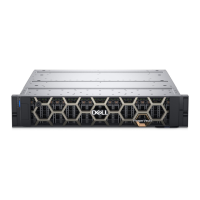Running Your Library
file:///T|/htdocs/stor-sys/ML6000/en/html/ch05.htm[9/17/2012 1:49:49 PM]
Note: Be sure to unload the tape drive before attempting to clean it. If the tape drive is loaded with a cartridge, it will
not available for this operation.
If you have at least one cleaning slot configured (see Configuring Cleaning Slots), and you are using the Web client, you can
choose to use a cleaning tape from either a configured cleaning slot or the topmost I/E station slot. If two or more cleaning
slots are configured and have cleaning tapes in them, the library chooses which cleaning tape to use. If you have zero
cleaning slots configured, or if you are using the operator panel, you must use a cleaning tape in the topmost I/E station slot.
You are prompted to insert a cleaning cartridge in the appropriate slot and select the tape drive you want to clean. The library
then takes the associated partition offline, moves the cleaning cartridge from the I/E station slot to the designated tape drive,
and cleans the tape drive. You will be asked to confirm that you want to take the partition offline.
When the operation is complete, the library moves the cleaning cartridge back to the I/E station slot and takes the partition
back online.
Note: If your library has zero I/E station slots, you will not be able to manually clean tape drives. See Configuring I/E
Station Slots.
For step-by-step procedures, see the library's online Help. To access the online Help system, click the Help icon at the top
right of the Web client or operator panel user interface.
The paths to open the appropriate screens are as follows:
• From the Web client, select Tools > Drive Operations > Clean a tape drive.
• From the operator panel, select Tools > Drive Mgmt > Clean drive.
About Tape Drive Operations
You can perform the following tape drive operations:
• Create a firmware upgrade (FUP) tape. A FUP tape can be created of a tape drive firmware version already in use in
your library. For more information, see Using an Image File to Upgrade Tape Drive Firmware.
• Erase a FUP tape. When a FUP tape is no longer needed, you can erase it and reuse it as a data cartridge or again as a
FUP tape. For more information, see Erasing a FUP Tape.
• Upgrade tape drive firmware using a FUP tape. For more information, see
Using a FUP Tape to Upgrade Tape Drive
Firmware.
• Upgrade tape drive firmware using a firmware image file. For more information, see
Using an Image File to Upgrade
Tape Drive Firmware.
• Retrieve tape drive logs. Tape drive logs can be retrieved from any tape drive installed in the library. For more
information, see Retrieving Tape Drive Logs.
• Retrieve tape drive sled logs. Tape drive sled logs can be retrieved from any sled installed in the library. For more
information, see Retrieving Tape Drive Sled Logs.
• Clean tape drives. Tape drive can be cleaned manually at any time. For more information, see
About Cleaning Tape
Drives.
• Upload/remove tape drive firmware for autoleveling. Available only for FC tape drives connected to an FC I/O blade.
For more information, see Autoleveling Tape Drive Firmware.
• Reset tape drives. Resetting a tape drive power cycles the tape drive while the tape drive remains in the drive sled in
the library. For more information, see Drive Reset.
Locking and Unlocking the I/E Stations
Each 5U Library Control Module and 9U Library Expansion Module has an I/E station door with multiple open and close
sensors. A secondary door located behind the I/E station door acts as a redundant indicator as to whether the I/E station is
opened or closed. When you are finished accessing the I/E station, make sure the station door is fully closed.
Administrators can use this operation to lock or unlock the doors for all I/E stations that are configured as I/E station slots. If
all I/E station slots are configured as storage, this operation unlocks the 5U Library Control Module I/E station only.
Note: Some host applications use a command to lock and unlock I/E station doors. This command usually cannot be
overridden by the library. Use the host application to lock or unlock I/E station doors if this occurs. Using the library
lock/unlock operation may affect the host application. See your host application documentation for information.

